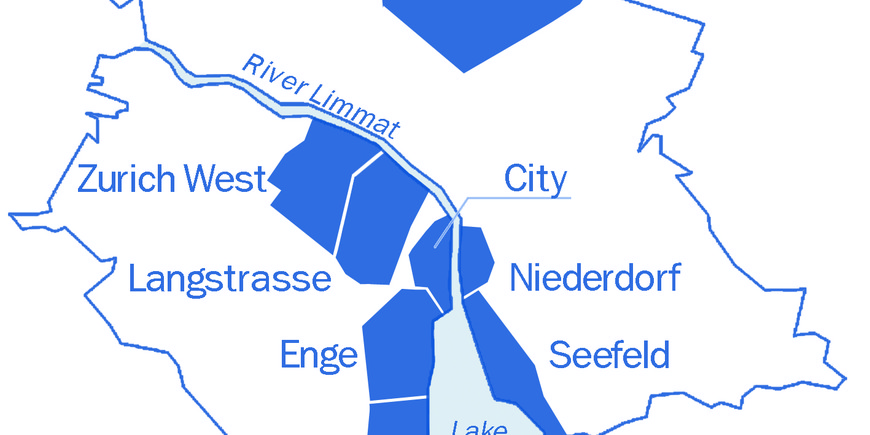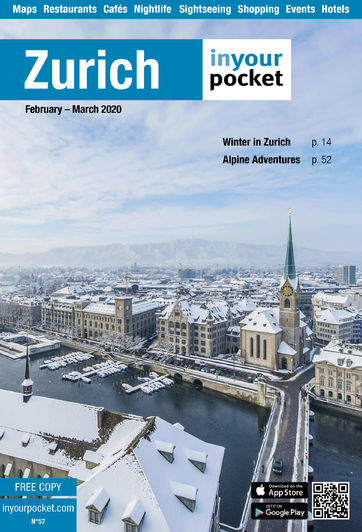The City of Zurich officially has 12 urban districts, called Stadtkreise. They are simply numbered from 1 to 12. However these urban districts are mostly for administrative purposes - we introduce the areas visitors to Zurich should know by the names they are usually known by. The numbers in brackets show roughly which official districts they include.
Jump to:
City/Lindenhof
On the western side of the Limmat river lies the Lindenhof quarter, the other part of the old town. Right in it’s centre, on a small hill, Lindenhofplatz gives you excellent views over Niederdorf. Zurich’s citizens held their meetings here in mediaeval times. The alleys and streets near here abound with shops of all kinds and some restaurants and bars. Towards the west, Bahnhofstrasse - one of the world’s most famous shopping streets - marks the border of the Lindenhof district, and on the other side, the so-called City includes Paradeplatz and the financial and business district, spreading out towards the lake. The City is delimited by the Schanzengraben, an artificial moat from the lake to the river Sihl, built in the 17th and 18th century to protect the citizens from all kind of attacks. These days things are more relaxed and you can stroll along the Schanzengraben, mostly on wooden footbridges or stone ledges just by the waterside.
Enge & Wollishofen
The western shore of Lake Zurich is a bit less popular, but that’s exactly why it’s worth a visit. When the Seefeld side is overcrowded on a sunny summer weekend, you might find it more relaxing on this side. For example swimming at Mythenquai, or on Landiwiese, right on the shore. Enge district houses the two gardens Belvoirpark and Rieterpark as well.
Langstrasse
The Langstrasse (long street) is a street connecting districts 4 and 5 through a tunnel underneath the ocean of railway tracks which divide the western part of the city. Some people still think the street and its surroundings are an ugly, unpleasant area - but they’re usually the ones who haven’t been there for years. It was once the best-known red light district in Switzerland. But in the last decade much has changed: more and more striptease and night clubs have changed into urban bars now very popular with Zurich’s young crowd. You will still find strip clubs, some street prostitution and a few alcoholics - but some of the most interesting bars, restaurants and clubs in the city as well (see the nightlife chapter). As a result it’s Zurich’s most cosmopolitan and multi-cultural district, perfect for bar-hopping and with options for partying almost around the clock.
Niederdorf
Niederdorf (the lower village) is the part of the old town lying on the eastern side of the Limmat river between the squares Central and Bellevue. It's teeming with restaurants, bars and, spiteful tongues say, undiscerning visitors from neighbouring canton Argovia (Argovians have to take a bit of flak in Zurich). There is also a sprinkling of adult entertainment, especially in and around Härringstrasse sex workers of both sexes look for suitors. Most of Niederdorf is a pedestrian area. It’s criss-crossed with mediaeval alleys and small squares and a walk through Niederdorf should be part of every visit to Zurich. Especially if you leave very busy Niederdorfstrasse up hill towards Oberdorf you will discover some lovely spots you wouldnât have expected. Along the river on the Limmatquai cafés with outdoor seating are a good excuse to have a drink and watch Zurich go by.
Seefeld
Seefeld is the name of the district on the eastern shore of the lake. Over the past decade it has become an incredibly popular area to live in - which results in very high rents. There are some worries that this is driving away the area’s original inhabitants and spoiling its charm. With all the new residents in the area, scores of trendy bars and restaurants have opened in Seefeld. But of course the major attraction here is the lake: On the lake side there is a promenade with boat rentals, two swimming spots and the ever (over-)crowded Blatterwiese, where you can sunbathe on the grass, barbecue on two electric grills or dine in one of the outdoor restaurants. Don’t leave Zurich without having taken in the lake side.
Zürich Nord - Oerlikon
The urban district 11 in the north of Zurich, behind the two hills Käferberg and Zürichberg is often referred to as Zurich Nord. The villages Oerlikon, Affoltern, Seebach merged with Zurich in 1934. Close to the airport, Oerlikon is home to numerous companies today, and to Zurich’s biggest event hall Hallenstadion and the trade fair grounds. Lots of housing, offices, parks and hotels have been built here in the past five years.
Zürich West
Probably Zurich’s fastest developing district, this formerly industrial part of the city is rapidly changing into a new business and residential area. Office space and residential developments have sprouted everywhere, making construction sites a long-term feature. The area around Escher-Wyss-Platz has also become one of the city’s entertainment districts with bars, restaurants and clubs springing up like mushrooms over the last 15 years. The first clubs set up in abandoned industrial buildings, but now many have moved into newly built or renovated locations. On the waste land on Geroldstrasse (aka street of clubs), the clubs still have a raw, provisional feel, while the restaurants and bars around the large Abaton multiplex cinema have a more mainstream character. Thanks to its proximity to the train station Hardbrücke with night connections to the suburbs of Zurich, the area is flooded with suburban youngsters on the weekends





